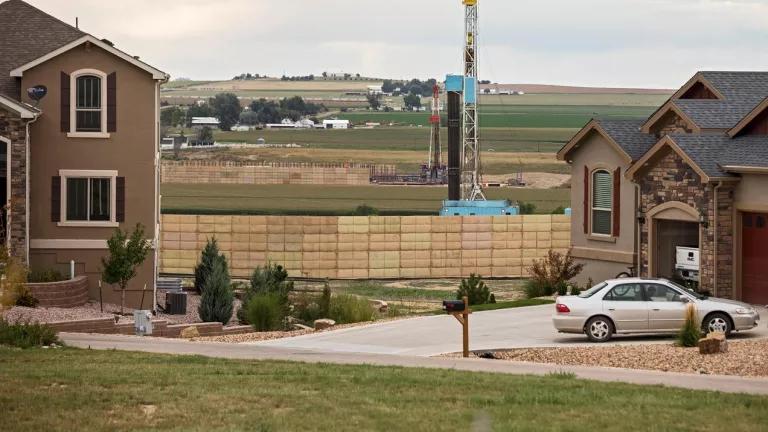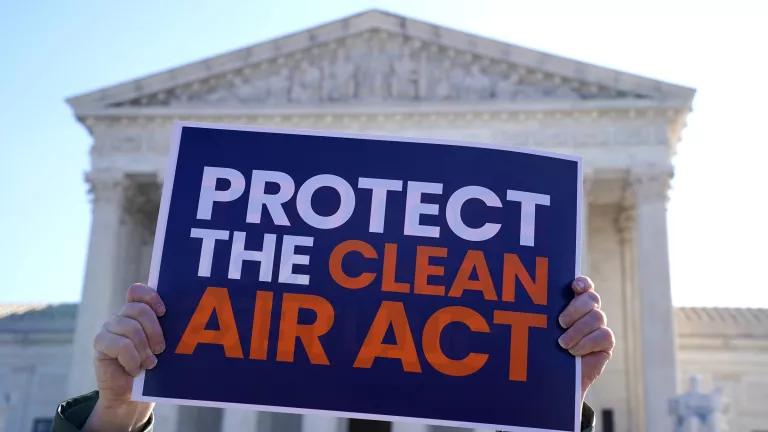Regulation Is Too Weak for Radioactive Oil and Gas Waste
The U.S. oil and gas industry produced an estimated one trillion gallons of produced water in 2017. And this waste—along with drilling and fracking waste—can contain radioactive elements known as “technologically enhanced naturally occurring radioactive material,” or TENORM. A new NRDC report describes these risks and how weak regulations fail to appropriately protect workers and communities.

Fracking rigs near new homes in Weld County, Colorado
The U.S. oil and gas industry produced an estimated one trillion gallons of produced water in 2017. And this waste—along with drilling and fracking waste--can contain radioactive elements known as “technologically enhanced naturally occurring radioactive material,” or TENORM. A new NRDC report describes these risks and how weak regulations fail to appropriately protect workers and communities.
TENORM that is not adequately managed poses significant health threats to oil and gas workers and their families and people who live near oil and gas operations. Nearby residents may face an increased risk of cancer. Making the situation even more dangerous, many oil and gas activities take place in residential neighborhoods, in close proximity to homes, schools, and playgrounds. My colleague Bemnet Alemayehu details the health threats from oil and gas TENORM here.
Despite the clear health risks, there are no dedicated federal regulations to ensure comprehensive and safer management of radioactive oil and gas materials. Bedrock federal environmental, health, and safety laws have gaping loopholes and exemptions that allow radioactive oil and gas materials to go virtually unregulated, including the Resource Conservation and Recovery Act that governs waste management, the Atomic Energy Act, the Clean Water Act, the Safe Drinking Water Act, and the Clean Air Act. Rules to protect workers, including truck drivers, also have significant gaps.
The Conference of Radiation Control Program Directors, an association of state and local professionals, has concluded that “no federal regulations explicitly govern the management and disposal of TENORM associated with the oil and gas industry.”
State regulations are also filled with gaps that allow unsafe practices for radioactive oil and gas waste. NRDC worked with Fair Shake Environmental Legal Services to review state regulations in the 12 states with the most oil and gas production. We looked at regulations for landfills that accept oil and gas waste, road-spreading, discharging into surface waters, and burying waste on a wellpad. Our review found that 4 of the 12 states have no standards at all for the level of radioactive material in oil and gas waste that can be accepted at landfills, only 3 require monitoring of radioactive material in the wastewater that leaches out of landfills, and 10 allow oil and gas waste to be spread on roads for uses such as dust suppression, deicing, or road maintenance.
Compounding the problem, radioactive oil and gas wastes are frequently transported across state lines as waste haulers take advantage of the lack of consistent state regulations to search for the cheapest or easiest way to dispose of radioactive material.
What does this mean for workers and communities? Our report details case studies where scientific research has found radioactive materials at high levels being released into the environment in Kentucky, North Dakota, Ohio, Pennsylvania, and Wyoming.
In order to protect vulnerable populations, state and federal lawmakers must take action to impose strong safeguards for oil and gas waste. Congress must close the oil and gas gaps in our federal laws so that oil and gas companies have to comply with the same laws that apply to other industries. In addition, states should establish comprehensive, state-of-the-art, protective regulations for the radioactive material generated by the oil and gas industry.
You can find more detailed information and recommendations in our report, available here.




